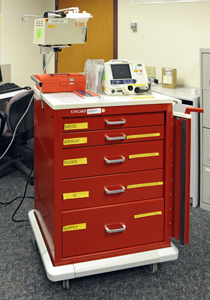This article is missing information about the origin of the term "crash cart". (March 2013) |

A crash cart, code cart, crash trolley or "MAX cart" is a set of trays/drawers/shelves on wheels used in hospitals for transportation and dispensing of emergency medication/equipment at site of medical/surgical emergency for life support protocols (ACLS/ALS) to potentially save someone's life. The cart carries instruments for cardiopulmonary resuscitation and other medical supplies while also functioning as a support litter for the patient.
The crash cart was originally designed and patented by ECRI Institute founder, Joel J. Nobel, M.D., while a surgical resident at Philadelphia's Pennsylvania Hospital in 1965.[contradictory] MAX helped enhance hospital's efficiency in emergencies by enabling doctors and nurses to save time, thereby increasing the chances of saving a life.
The contents and organization of a crash cart vary from hospital to hospital, country to country, and specialty to specialty, but typically contain the tools and drugs needed to treat a person in or near cardiac arrest or another life-threatening condition.[1][2][3] These include but are not limited to:
- Monitor/defibrillators, suction devices, and bag valve masks (BVMs) of different sizes
- Advanced cardiac life support (ACLS) drugs such as epinephrine, atropine, amiodarone, lidocaine, sodium bicarbonate, dopamine, and vasopressin
- First line drugs for treatment of common problems such as: adenosine, dextrose, epinephrine for IM use, naloxone, nitroglycerin, and others
- Drugs for rapid sequence intubation: succinylcholine or another paralytic, and a sedative such as etomidate, propofol or midazolam; endotracheal tubes and other intubating equipment
- Drugs for peripheral and central venous access
- Electronic metronome to provide standardized auditory cadence cues during CPR
- Pediatric equipment (common pediatric drugs, intubation equipment, etc.)
- Other drugs and equipment as chosen by the facility
Hospitals typically have internal intercom codes used for situations when someone has suffered a cardiac arrest or a similar potentially fatal condition outside of the emergency department or intensive care unit (where such conditions already happen frequently and do not require special announcements). When such codes are given, hospital staff and volunteers are expected to clear the corridors, and to direct visitors to stand aside as the crash cart and a team of physicians, pharmacists and nurses may come through at any moment. (See Code Blue.)
- ^ Milloy, Shaunna; Bubric, Katherine (2018-10-02). "A Four-Stage Method for Optimizing and Standardizing a Crash Cart Configuration". IISE Transactions on Occupational Ergonomics and Human Factors. 6 (3–4): 157–164. doi:10.1080/24725838.2018.1434574. ISSN 2472-5838. S2CID 169073651.
- ^ Jacquet, Gabrielle A.; Hamade, Bachar; Diab, Karim A.; Sawaya, Rasha; Dagher, Gilbert Abou; Hitti, Eveline; Bayram, Jamil D. (2018). "The Emergency Department Crash Cart: A systematic review and suggested contents". World Journal of Emergency Medicine. 9 (2): 93–98. doi:10.5847/wjem.j.1920-8642.2018.02.002. ISSN 1920-8642. PMC 5847507. PMID 29576820.
- ^ Shultz, Jonas; Davies, Jan M.; Caird, Jeff; Chisholm, Susan; Ruggles, Karen; Puls, Raymond (May 2010). "Standardizing anesthesia medication drawers using human factors and quality assurance methods". Canadian Journal of Anaesthesia. 57 (5): 490–499. doi:10.1007/s12630-010-9274-8. ISSN 1496-8975. PMID 20143279.